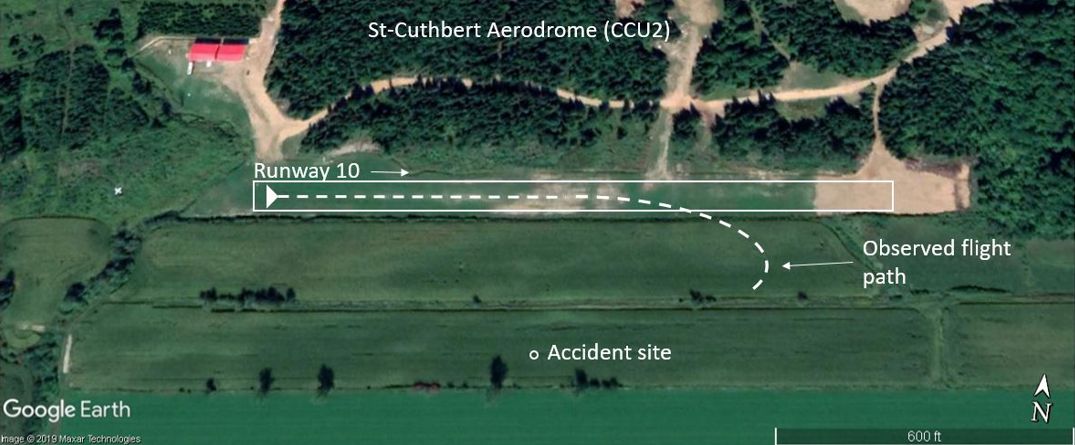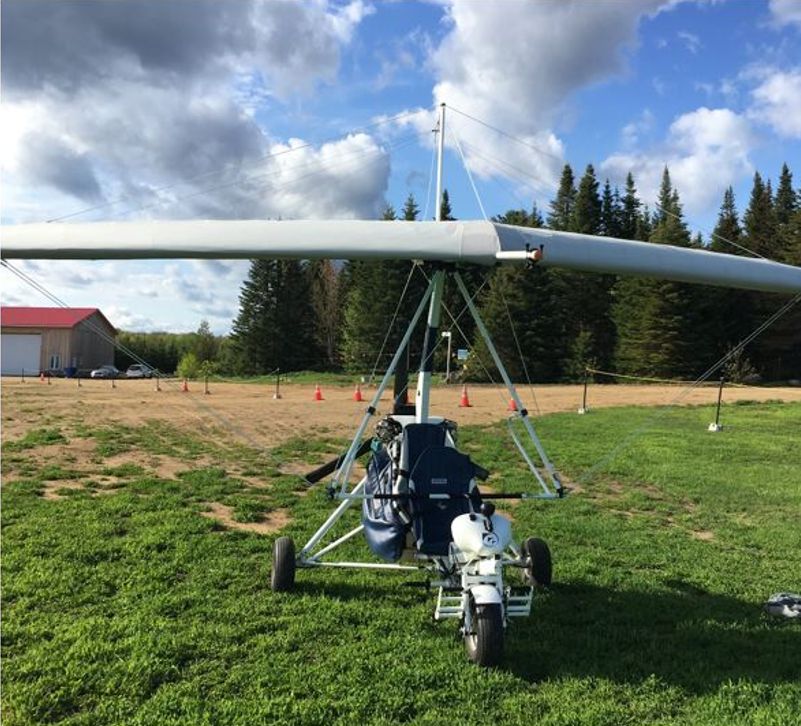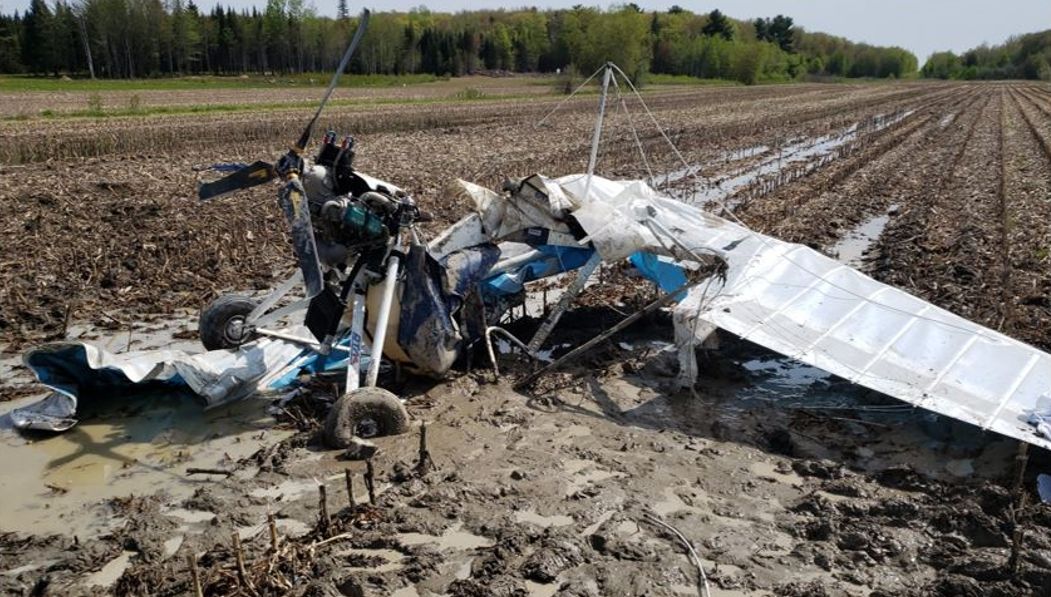Loss of control and collision with terrain
ULM Québec Inc.
DTA Voyageur II 912S (basic ultralight), C-IULM
St-Cuthbert (ULM Québec) Aerodrome, Quebec
The Transportation Safety Board of Canada (TSB) investigated this occurrence for the purpose of advancing transportation safety. It is not the function of the Board to assign fault or determine civil or criminal liability. This report is not created for use in the context of legal, disciplinary or other proceedings. See Ownership and use of content. Masculine pronouns and position titles may be used to signify all genders to comply with the Canadian Transportation Accident Investigation and Safety Board Act (S.C. 1989, c. 3).
History of the flight
On 24 May 2019, the DTA Voyageur II 912S basic ultralight aircraft (registration C-IULM, serial number 284), operated by ULM Québec Inc. (ULM Québec), departed St-Cuthbert (ULM Québec) Aerodrome (CCU2), Quebec, at approximately 1900,Footnote 1 with a student in the front seat and a pilot providing instruction sitting in the rear seat. For approximately 1 hour, the aircraft flew locally, completing several circuits at CCU2 and low-altitude flyovers of Runway 10.
At around 2000, the aircraft landed. The pilot providing instruction and the student switched seating positions for the next flight. The investigation could not determine why they changed seats, or if this was common practice.
At approximately 2008, the aircraft commenced a takeoff on Runway 10. During the initial climb over the runway, several engine backfiresFootnote 2 were heard. The aircraft then commenced a steep right turn and entered a dive before it disappeared behind a pile of hay bales. The aircraft struck the ground in an agricultural field south of the runway (Figure 1).
ULM Québec’s personnel rushed to the site to provide assistance to the occupants, calling 911 on the way, and shut down the engine, which was still running at high rpm. The impact forces caused substantial damage to the aircraft. The 2 occupants received fatal injuries.
Weather information
The 2000 aerodrome routine meteorological report (METAR) for Trois-Rivières Airport (CYRQ), which is located approximately 30 nautical miles (NM) east-northeast of the accident site, indicated winds from 230° true at 5 knots; visibility of 9 statute miles and a broken ceiling at 9500 feet above ground level. The weather at the time of the occurrence was not considered a factor in the accident.
Company and aerodrome information
ULM Québec Inc. is a Transport Canada (TC)–registered flight training unit under Subpart 406 of the Canadian Aviation Regulations (CARs) for the ultralight category. It operates at CCU2, a registered aerodrome located 2.6 NM northwest of the municipality of Saint-Cuthbert. CCU2 has a 1352 foot–long turf runway (Runway 10/28) and is mainly used by ultralight aircraft.
Pilot and student information
Records indicate that the pilot providing instruction had obtained an ultralight pilot permit in November 2018 and held a valid Category 3 medical certificate. However, he did not hold a flight instructor rating — ultra-light aeroplane to conduct flight training, as required under paragraph 425.21(2)(a) of the CARS Standard 425, Flight Training. He had accumulated approximately 100 total flight hours on ultralights. Nothing indicates that the pilot’s performance was degraded by physiological factors.
The student had started his ultralight pilot training in October 2018. At the time of the accident, he had completed the theoretical training and accumulated around 10 total flight hours, all with ULM Québec. Most of his dual instruction flights had been completed with the occurrence pilot.
Aircraft information
The DTA Voyageur II 912S is a single-engine, 2-seat ultralight trike which uses weight-shift as a means of flight control. It is powered by a 100-horsepower, 4-stroke Rotax 912 ULS engine and a fixed-pitch carbon fibre 3-blade propeller (Figure 2). The occurrence aircraft was equipped with optional dual controls and a DTA Diva wing allowing for a 472.5 kg maximum take-off weight. Dual controls are provided by extensions bolted to the rear of the flight control bar, which allow the pilot providing instruction and sitting in the rear seat to have a grip on the controls. Students learn to fly the aircraft using the front seat exclusively. The aircraft was registered in the basic ultralight category.
Delta Trike Aviation (DTA), the manufacturer of the occurrence aircraft, stipulates the following in its instruction manual for the DTA Voyageur II 912S:
Flight Envelope Limitations
CF WING MANUEL [sic]
- Maximum Angle of Bank 60°
- Maximum Pitch +/- 45°
The observance of this flight envelope is imperative. This Aircraft (ULM) is NOT designed for aerobatic flight. Flight manoeuvres which result in negative load factors are completely prohibited. […]
Beyond the limits (bank 60°; pitch ±45°), loss of stability or control, structural failure, or tumbling can occur.Footnote 3
The same information is contained in DTA’s Diva wing user and maintenance manual.Footnote 4
Basic ultralights
A basic ultralight is defined in the CARs as:
an aeroplane having no more than 2 seats, designed and manufactured to have
- a maximum take-off weight not exceeding 544 kg, and
- a stall speed in the landing configuration (Vso) of 39 knots (45 mph) indicated airspeed, or less, at the maximum take-off weight.Footnote 5
Basic ultralights may be used recreationally in Canada in accordance with section 602.29 of the CARs. The carriage of a passenger is prohibited.Footnote 6 Basic ultralights may be used for hire and reward for the purpose of pilot flight training only; any other commercial aviation operation using basic ultralights is prohibited.Footnote 7 Occupants must wear a protective helmet.Footnote 8
Basic ultralights are operated without a certificate of airworthiness, which means that the design, construction and maintenance of the aircraft are not subject to any form of oversight by TC. It is the owner’s responsibility to maintain the aircraft so that it is safe for flight.Footnote 9
Accident site and wreckage information
The collision with terrain occurred at CCU2, approximately 375 feet south of the Runway 10/28 centreline, in an agricultural field parallel to the runway. The recent snow thaw had left several inches of mud and water in certain areas (Figure 3).
The tricycle, wing, engine, and propeller were examined at the accident site. Damage to the tricycle indicated that it collided with the ground in a right-bank slip and steep nose-down attitude. The impact forces caused the front of the main frame member of the tricycle to bend left and upward several degrees. The nose wheel and steering mechanism was displaced aft and turned several degrees past its normal maximum deflection. On the occurrence aircraft, engine throttle could be controlled by the right pedal for the front seat or by a small lever located on the right footrest for the rear seat. Upon impact with the ground, deformation of the right pedal and footrest caused the throttle cable to be pulled and the engine to reach a high rpm. The engine operated at high rpm for several minutes until ULM Québec’s personnel were able to shut it down.
The wing tubular structure was found to have several deformed and fractured components. On-site examination of the wing revealed that it impacted the ground on the nose and left leading edge. Tearing damage was present on the left-wing trailing edge as a result of contact with the rotating propeller. Damage to the control bar and the position at which it was found were consistent with the pilot attempting to recover from the dive with a left turn before impact with the ground. All damage to the wing, including that caused by the rotating propeller, was found to have been a consequence of the impact with the ground.
The engine showed very little impactdamage, but the tips of the propeller blades had impact marks. Wing-covering material was found wrapped around the propeller shaft. On-site examination of the engine, the fuel system and the ignition system did not reveal any anomalies. The engine, along with several other components,Footnote 10 was removed and sent to Rotech Flight Safety Inc. in Vernon, British Columbia, for further examination and testing in the presence of the manufacturer and a TSB investigator. The engine was installed on a test stand, started and operated at various settings. All test results were normal. The engine tachometer was examined at the TSB Engineering Laboratory in Ottawa, Ontario, but no pointer-to-face witness marks were noted. Therefore, the engine rpm at the time of collision with the ground remains unknown. The investigation could not determine what caused the reported engine backfires during takeoff.
Aerodynamic stall during a turn
The investigation determined that the engine backfired during the initial climb over the runway. Subsequently, the aircraft was in a steep bank (between 60° and 90°) during the right turn, and it then entered a dive. The scenario considered most plausible by the investigation was a loss of control during the turn with insufficient altitude to recover before impact with the ground.
During takeoff, all aircraft transition through a vulnerable period of low speed at low altitude. Pilots must ensure that they do not exceed critical angles of attack while in this regime.
In a turn, as the bank angle increases, there is a corresponding increase in the load factorFootnote 11 and stall speed. In a turn where a 60° bank angle is reached, the load factor on the aircraft is increased by 100% and stall speed by 40%.Footnote 12 Therefore, a high-load-factor manoeuvre such as a steep turn initiated when the aircraft nears the stall speed may result in the aircraft inadvertently stalling.
In an ultralight trike, a turn performed at too low a speed or at too steep a bank angle will produce a significant slip, a dive, a stall, or a combination of the three.Footnote 13 In all cases, a significant loss of altitude may be expected, which may result in the aircraft striking the ground if its altitude is not sufficient for a recovery.
Safety messages
An unexpected engine issue during takeoff leaves the pilot with very little time to take appropriate action. Selecting a forced landing location within a limited arc in front of the aircraft may be the best option in this situation.
Attempting a steep turn during the transition through the vulnerable period of low speed at low altitude following takeoff is dangerous. It may not be possible to recover from a loss of control occurring at low altitude in time to avoid an impact with terrain. Pilots must be aware of the performance degradation of their aircraft when manoeuvring and should refrain from making a steep turn during initial climb.
This report concludes the Transportation Safety Board of Canada’s investigation into this occurrence. The Board authorized the release of this report on . It was officially released on .


